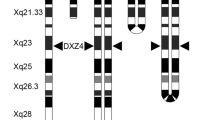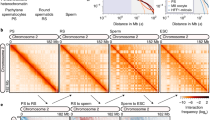Abstract
The condensation behaviour of the human Y chromosome in germ cells and Sertoli cells of pre- and post-pubertal testes was followed by fluorescence in situ hybridisation using probes for three different regions of the Y chromosome. Patterns of expansion or contraction of signal are taken to reflect degrees of condensation of the related Y chromatin and hence its potential for genetic activity. For probe pHY2.1, which labels the distal non-fluorescent and fluorescent heterochromatin of the Y chromosome (Yq12), an expanded signal seen in gonocytes of the prepubertal testis is superseded by a condensed signal seen in adult germ cells at all but the zygotene stage of meiotic prophase when meiotic pairing takes place. In contrast, Sertoli cells show a condensed signal pre-pubertally but a greatly expanded signal in the adult testis. A totally condensed pHY2.1 signal is found in a chromosomally normal man with Sertoli-cell-only syndrome. It is hypothesised that control over at least some facets of spermatogenesis may not, in the adult, be autonomous to the germ cells, but rather may emanate from the Sertoli cells. Chromatin expansion at zygotene could, however, be important for pairing and crossing over in the XY bivalent, successful synapsis ensuring survival of spermatocytes into the post-meiotic stages.
Similar content being viewed by others
References
Arnoldus EPJ, Peters ACB, Bots GTAM, Raap AK, van derPloeg M (1989) Somatic pairing of chromosome 1 centromeres in interphase nuclei of human cerebellum. Hum Genet 83: 231–234
Beechey CV (1973) X-Y chromosome dissociation and sterility in the mouse. Cytogenet Cell Genet 12: 60–67
Bernstein R, Rosendorf J, Ramsay M, Pinto MR, Page DC (1987) A unique dicentric X; Y translocation with Xq and Yp breakpoints: cytogenetic and molecular studies. Am J Hum Genet 41: 145–156
Bishop CE, Weith A, Mattei M-G, Roberts C (1988) Molecular aspects of sex determination in mice: an alternative model for the origin of the Sxr region. Philos Trans R Soc Lond [Biol] 322: 119–124
Brandriff BF, Gordon LA, Segraves R, Pinkel D (1991) The malederived genome after sperm-egg fusion: spatial distribution of chromosomal DNA and paternal-maternal genomic association. Chromosoma 100: 262–266
Burgoyne PS (1987) The role of the mammalian Y chromosome in spermatogenesis. Development [Suppl] 101: 133–141
Burgoyne PS (1991) Y chromosome function in mammalian development. In: Wassarman PM (ed) Advances in developmental biology, vol 1. JA1 Press, Connecticut London, pp 1–29
Burgoyne PS, Levy ER, McLaren A (1986) Spermatogenic failure in male mice lacking H-Y antigen. Nature 320: 170–172
Burgoyne PS, Mahadevaiah SK, Sutcliffe MJ, Palmer SJ (1992) Fertility in mice requires X-Y pairing and a Y-chromosomal “spermiogenesis” gene mapping to the long arm. Cell 71 391–398
Chandley AC (1973) Univalent sex chromosomes and meiotic arrest in man. Heredity 30: 262 (Abstract)
Chandley AC, McBeath S (1987) DNAse I hypersensitive sites along the XY bivalent at meiosis in man include the XpYp pairing region. Cytogenet Cell Genet 44: 22–31
Chandley AC, Goetz P, Hargreave TB, Joseph AM, Speed RM (1984) On the nature and extent of XY pairing at meiotic prophase in man. Cytogenet Cell Genet 38: 241–247
Chandley AC, Gosden JR, Hargreave TB, Spowart G, Speed RM, McBeath S (1989) Deleted Yq in the sterile son of a man with a satellited Y chromosome (Yqs). J Med Genet 26: 145–153
Cooke HJ (1976) Repeated sequence specific to human males. Nature 262: 182–186
Cooke HJ, Hindley J (1979) Cloning of human satellite III DNA: different components are on different chromosomes. Nucleic Acids Res 6: 3177–3197
Djakiew D, Dym M (1988) Pachytene spermatocyte proteins influence Sertoli cell function. Biol Reprod 39: 1193–1205
Evans EP, Breckon G, Ford CE (1964) An air-drying method for meiotic preparations from mammalian testes. Cytogenetics 3: 289–294
Guttenbach M, Schmid M (1991) Non-isotopic detection of chromosome 1 in human meiosis and demonstration of disomic sperm nuclei. Hum Genet 87: 261–265
Guttenbach M, Schmid M, Jausch A, Vogt P (1989) The Y chromosome of the mouse is decondensed in Sertoli cells. Chromosoma 97: 429–433
Handel MA, Hunt PA (1992) Sex chromosome pairing and activity during mammalian meiosis. Bioessays 14: 817–822
Lawrence JB, Villnave CA, Singer RH (1988) Sensitive, high-resolution chromatin and chromosome mapping in situ: presence and orientation of two closely integrated copies of EBV in a lymphoma line. Cell 52: 51–61
Lifschytz E, Lindsley DL (1972) The role of X-chromosome inactivation during spermatogenesis. Proc Natl Acad Sci USA 69: 182–186
Manuelidis L, Borden J (1988) Reproducible compartmentalization of individual chromosome domains in human CNS cells revealed by in situ hybridisation and three-dimensional reconstruction. Chromosoma 96: 397–410
Matsuda Y, Hirobe T, Chapman VM (1991) Genetic basis of X-Y dissociation and male sterility in interspecific hybrids. Proc Natl Acad Sci USA 88: 4850–4854
Monesi V (1971) Chromosome activities during meiosis and spermatogenesis. J Repord Fertil [Suppl] 13: 1–14
Speed RM (1986) Abnormal RNA synthesis in sex vesicles of tertiary trisomic male mice. Chromosoma 93: 267–270
Sutcliffe MJ, Burgoyne PS (1989) Analysis of the testes of H-Y negative XOSxrb mice suggests that the spermatogenesis gene (Spy) acts during the differentiation of the A spermatogonia. Development 107: 373–380
Thomas BJ, Rothstein R (1991) Sex, maps and imprinting. Cell 64: 1–3
Tiepolo L, Zuffardi O (1976) Localization of factors controlling spermatogenesis in the non-fluorescent portion of the human Y chromosome long arm. Hum Genet 34: 119–124
Tres LL (1975) Nucleolar RNA synthesis of meiotic prophase spermatocytes in the human testis. Chromosoma 53: 141–151
Weintraub H, Groudine M (1976) Chromosomal subunits in active genes have an altered conformation. Science 193: 848–856
Author information
Authors and Affiliations
Additional information
Communicated by: W. Hennig
Rights and permissions
About this article
Cite this article
Speed, R.M., Vogt, P., Köhler, M.R. et al. Chromatin condensation behaviour of the Y chromosomes in the human testis. Chromosoma 102, 421–427 (1993). https://doi.org/10.1007/BF00360407
Received:
Revised:
Accepted:
Issue Date:
DOI: https://doi.org/10.1007/BF00360407




